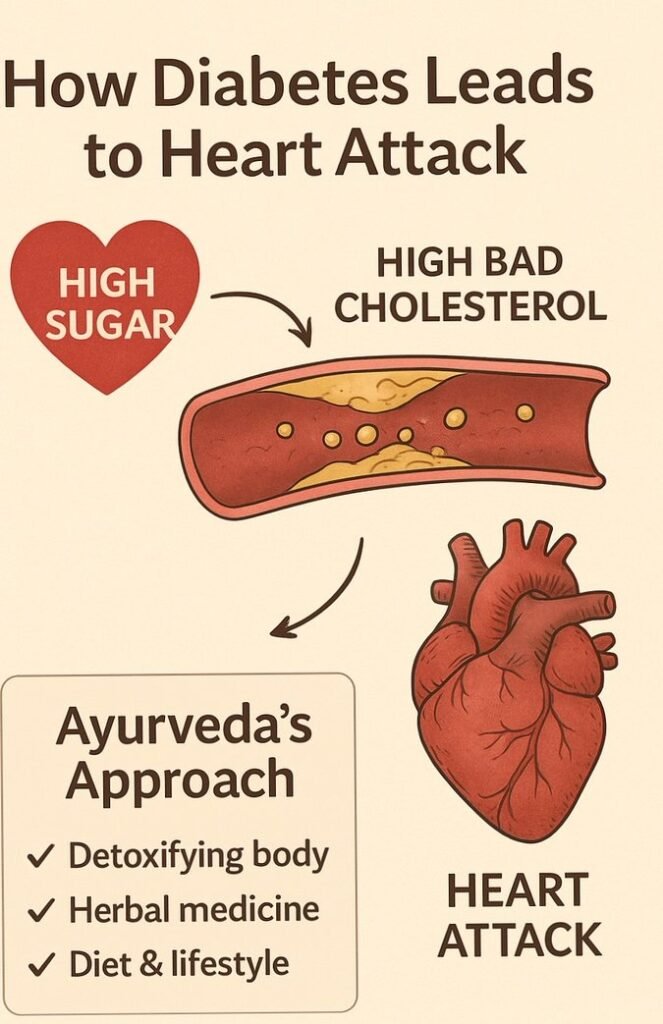Ayurveda, often referred to as the “science of life,” is one of the world’s oldest holistic healing systems, originating in India over 5,000 years ago. Rooted in the ancient Vedic texts, it emphasizes balance among the body, mind, and spirit to achieve optimal health. The system is built on the concept of three doshas—Vata (air and space), Pitta (fire and water), and Kapha (earth and water)—which govern physiological functions. When these doshas are in equilibrium, health prevails; imbalances lead to disease. Ayurveda and diabetes treatment has always been questioned for its effectiveness. In our experience following the tips given under, works miracles.
Type 2 diabetes mellitus (T2DM) is a chronic metabolic disorder characterized by high blood glucose levels due to insulin resistance or insufficient insulin production. From a modern medical perspective, it develops when the body fails to use insulin effectively, leading to glucose buildup in the blood instead of being utilized for energy. Risk factors include age (over 45), family history, obesity, physical inactivity, high blood pressure, and certain ethnic backgrounds such as African American, Hispanic/Latino, American Indian, Asian American, or Pacific Islander. Symptoms may include increased thirst, frequent urination, fatigue, blurred vision, slow-healing sores, and unexplained weight loss, though they can be mild or absent initially. Without management, complications like heart disease, stroke, nerve damage, kidney disease, eye problems, and dementia can arise. Diagnosis involves blood tests, and treatment focuses on lifestyle changes, medications, and monitoring blood glucose, pressure, and cholesterol.
In Ayurveda, diabetes is known as “Madhumeha” or “Prameha,” translating to “honey-like urine” due to the sweet taste of urine in affected individuals. It is classified under metabolic disorders caused primarily by Kapha dosha imbalance, often exacerbated by poor diet, sedentary lifestyle, and stress. Ayurveda views T2DM not as an isolated condition but as a systemic imbalance affecting digestion (Agni), tissues (Dhatus), and waste elimination (Malas). Unlike conventional medicine, which often targets symptoms with medications, Ayurveda aims for root-cause correction through personalized herbs, diet, lifestyle, yoga, and detoxification. This holistic approach has gained attention for its potential in managing T2DM, with emerging evidence supporting its efficacy.
This article explores Ayurveda’s role in treating T2DM, drawing from ancient texts like the Charaka Samhita and Sushruta Samhita, modern scientific studies, and practical recommendations. By integrating “Ayurveda and Diabetes” principles, individuals can potentially achieve better glycemic control, reduce complications, and enhance quality of life.

Ayurvedic Perspective on Diabetes
In Ayurvedic texts, diabetes is described as “Prameha,” a group of urinary disorders with 20 subtypes based on dosha predominance. Madhumeha, the most severe form akin to T2DM, is Kapha-dominant but can involve Vata or Pitta imbalances in advanced stages. The Charaka Samhita (Sutrasthana 30) and Sushruta Samhita (Sutrasthana 1) outline Ashtanga (eight branches) of Ayurveda, including Kayachikitsa (internal medicine), which addresses Prameha.
The pathogenesis begins with impaired Agni (digestive fire), leading to Ama (toxins) accumulation. Excessive intake of Kapha-aggravating foods—like sweets, dairy, and heavy grains—clogs channels (Srotas), impairing insulin-like functions and causing polyuria, polydipsia, and fatigue. Genetic predisposition (Beeja Dosha) and lifestyle factors (Ahar-Vihar) are key contributors.
Diagnosis in Ayurveda involves assessing Prakriti (constitution), Vikriti (imbalance), pulse (Nadi Pariksha), tongue, urine, and symptoms. For instance, sweet urine indicates Madhumeha. Treatment is individualized: Kapha types focus on bitter, astringent therapies; Vata-dominant cases emphasize nourishment.
Scientific correlations show Ayurveda’s dosha theory aligns with modern metabolic concepts. Kapha imbalance mirrors insulin resistance, while Ama resembles oxidative stress. Studies indicate Ayurvedic interventions can lower HbA1c by addressing these root causes.
Ayurvedic Diagnostic Approaches
Ayurveda employs a tri-fold diagnostic method: Darshana (observation), Sparshana (touch/pulse), and Prashna (questioning). For T2DM, signs include excessive urination, thirst, sweet body odor, and lethargy. Urine analysis (Mutra Pariksha) checks for turbidity or sweetness.
Modern integration includes monitoring HbA1c, fasting blood sugar (FBS), and postprandial blood sugar (PPBS), alongside Ayurvedic assessments. A study on integrated Ayurveda-Yoga protocols showed improved glycemic control without adverse effects.
Herbal Remedies in Ayurveda for Diabetes
Ayurveda relies heavily on herbs (Dravyaguna) for T2DM management. These plants possess anti-hyperglycemic, antioxidant, and anti-inflammatory properties, often mimicking insulin or enhancing sensitivity.
- Bitter Melon (Momordica charantia – Karela): Contains charantin and polypeptide-p, which lower blood glucose by acting like insulin. Studies show it reduces FBS and HbA1c. Consume as juice (30-50ml daily) or cooked vegetable.
- Fenugreek (Trigonella foenum-graecum – Methi): Rich in soluble fiber, it slows carbohydrate absorption, improving insulin sensitivity. A meta-analysis confirmed its efficacy in reducing HbA1c. Soak seeds overnight and drink the water.
- Turmeric (Curcuma longa – Haldi): Curcumin has anti-inflammatory effects, protecting pancreatic beta-cells. It lowers glucose and prevents complications like neuropathy. Mix with milk (golden milk) for daily intake.
- Gymnema Sylvestre (Gurmar): Known as “sugar destroyer,” it blocks sugar absorption and regenerates beta-cells. Clinical trials show reduced sugar cravings and HbA1c. Tea from leaves is ideal.
- Indian Gooseberry (Emblica officinalis – Amla): High in vitamin C, it enhances insulin secretion and reduces oxidative stress. Triphala (Amla + Haritaki + Bibhitaki) is a common formulation.
- Neem (Azadirachta indica): Bitter leaves detoxify and lower glucose. Used for wound healing in diabetic patients.
- Tinospora cordifolia (Guduchi): Boosts immunity and regulates sugar. Effective in reducing FBS.
Proprietary formulations like Diabecon, Hyponidd, and Madhunashini show promising results in trials, lowering HbA1c without side effects. A review of 7 RCTs (354 participants) found significant FBS and HbA1c reductions with herbs like Diabecon.
Always consult an Ayurvedic practitioner for dosages, as herbs can interact with medications.

Diet and Nutrition in Ayurveda for Diabetes
Ahara (diet) is pivotal in Ayurveda. For T2DM, emphasize bitter (Tikta), astringent (Kashaya), and pungent (Katu) tastes to pacify Kapha. Avoid sweet (Madhura), sour (Amla), and salty (Lavana) foods.
Recommended Foods:
- Grains: Barley, millet, quinoa (light and dry).
- Vegetables: Bitter gourd, fenugreek leaves, drumstick, leafy greens.
- Fruits: Amla, jamun, pomegranate (in moderation).
- Proteins: Moong dal, chickpeas, fish (for non-vegetarians).
- Spices: Turmeric, cumin, coriander, ginger.
- Beverages: Herbal teas (fenugreek, cinnamon).
Avoid: Sugar, rice, potatoes, dairy (except buttermilk), fried foods.
Sample Daily Diet:
- Breakfast: Barley porridge with vegetables.
- Lunch: Moong dal soup, salad, millet roti.
- Snack: Amla juice.
- Dinner: Vegetable stir-fry with quinoa.
Portion control: 50-60% carbs from complex sources, 15% proteins, rest fats. Eat at regular times to stabilize Agni. Studies show Ayurvedic diets reduce HbA1c and improve lipid profiles.
Lifestyle Recommendations
Vihara (lifestyle) includes Dinacharya (daily routine). Rise early, practice oil pulling, exercise moderately.
- Exercise: Walking (1000 steps post-meals), swimming.
- Sleep: 7-8 hours, avoid daytime naps.
- Stress Management: Meditation, Abhyanga (oil massage).
A case report highlighted obesity-induced T2DM reversal through diet and lifestyle.
Panchakarma and Other Therapies
Panchakarma detoxifies: Vamana (emesis), Virechana (purgation), Basti (enema). For T2DM, Virechana clears Ama. Therapies like Dhanyamladhara (fermented cereal pour) and Snehapana (ghee intake) aid. Udwartana (herbal powder massage) reduces fat.
Yoga and Pranayama for Diabetes Control
Yoga enhances insulin sensitivity. Asanas: Vakrasana (twisted pose) stimulates pancreas; Dhanurasana, Ardhamatsyendrasana lower glucose. Pranayama: Kapalabhati, Anulom-Vilom.
A study showed yoga reduces FBS and improves quality of life.

Scientific Evidence and Case Studies
Over 50 studies support Ayurveda. A PMC review found top herbs effective in T2DM. Integrated protocols reversed insulin resistance.
Case: A patient at a well-known ayurvedic practitioner reduced HbA1c from 11.2% to 5.7% in 9 months via herbs, diet, and Panchakarma. Another reversed via yoga and herbs.
Integration with Modern Medicine
Ayurveda complements allopathy. Monitor with tests; avoid self-medication. Precautions: Hypoglycemia risk with herbs; consult for kidney/liver issues.
Conclusion
Ayurveda offers a profound, evidence-backed approach to T2DM, emphasizing balance and prevention. By adopting “Ayurveda and Diabetes” strategies, individuals can manage symptoms, reduce reliance on medications, and foster longevity. Consult me for personalized plans. This information is for educational purposes and not medical advice.





0 Comments